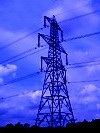
Renewable does not mean green. That is the claim of Jesse Ausubel of the Rockefeller University in New York. He explains that building enough wind farms, tidal power stations, hydroelectric dams, and electric generators running on biomass to meet global energy demands will wreck the environment rather than save it.
Ausubel has analysed the amount of energy that each so-called renewable source can produce in terms of watts of power output per square metre and compared this with what might be possible using nuclear power instead. “Nuclear energy is green,” he claims, “Considered in watts per square metre, nuclear has astronomical advantages over its competitors.”
While vast sums of money are being invested in alternative energy sources based on wind, water, and biomass, nuclear industry expertise is being squandered. “In order to grow, the nuclear industry must extend beyond its niche of electric power generation,” says Ausubel. He suggests that the nuclear industry could form an alliance with methane suppliers to produce green power in the form of hydrogen for powering electricity-generating fuel cells, not only in vehicles but in other areas inaccessible to the conventional electricity grid. Such technologies will succeed when economies of scale form part of their conditions of evolution, Ausubel explains. In contrast, there are, he suggests no economies of scale involved in simply erecting more and more wind turbines.
Underpinning Ausubel’s argument is the need for “decarbonisation”, by which he means our reliance on producing energy by converting carbon compounds, coal, oil, and gas, into carbon dioxide and water. Hydrogen, in contrast, is as innocent as an element can be, ending combustion as water, with no carbon dioxide greenhouse gas emission. The intrinsic problem in developing a hydrogen-based power economy as opposed to one that relies on carbon compounds, is that energy is required to produce hydrogen. Hydrogen production could be the future role of the nuclear power industry, Ausubel explains – the use of its entirely renewable and almost endless energy supply in the production of hydrogen.
Ausubel considers each so-called renewable in turn. He points out that hypothetically flooding the entire province of Ontario, Canada, about 900,000 square km, with its entire 680,000 billion litres of rainfall, and storing it behind a 60 metre dam would only generate 80% of the total power output of Canada’s 25 nuclear power stations. Put another way, each square kilometre of dammed land would provide the electricity for just 12 people.
Similarly, biomass, which produces less than a fifth of the USA’s renewable energy, is almost as energy inefficient. Most biomass comes from the liquor of paper pulp mills, which is burned to economise the heat and power of paper factories. But, in terms of decarbonisation, this biomass, which initially comes from farmed trees, represents a 10 to 1 ratio of carbon atoms per hydrogen atom, which is less than oil at 1 to 2.
Some people would argue that the use of biomass would be carbon neutral because trees absorb carbon dioxide to grow. However, in order to fulfil the energy requirements of a large proportion of a nation based on biomass, a large proportion of the land area would have to be planted to biomass forest. To obtain the same electricity from biomass as from a single nuclear power plant would require 2500 square kilometres of land working at optimal efficiency. Growth, harvesting and collection are not 100% efficient, relying as they do on high yields and powered equipment and vehicles.

Turning to the issue of wind, Ausubel points out that while wind farms are between three to ten times more compact than a biomass farm, a 770 square kilometre area is needed to produce as much energy as one 1000 Megawatt electric (MWe) nuclear plant. Moreover, wind farms can only be operated at two of the four wind speed ranges. Calm air means no power, of course, but gales faster than 25 metres per second (about 90 kilometres per hour) also means shutting down the turbines to prevent serious damage. To meet 2005 US electricity demand and assuming round-the-clock wind at the right speed, an area the size of Texas, approximately 780,000 square kilometres, would be needed.
Economies of scale stop with wind. One hundred windy square metres, a good size for a Manhattan apartment, could power an electric lamp or two, but not the laundry equipment, microwave oven, plasma TV, and computer. New York City would require every square metre of Connecticut to become a wind farm to fully power all its electrical equipment and gadgets.
Ausubel gives short thrift to solar power too, which he points out still operates at less than 10% efficiency despite three decades of research. A 1000 MWe photovoltaic solar cell plant would require about 150 square kilometres plus land for storage and retrieval.
The energy density of nuclear fuel is between 10,000 and 100,000 times as great as the most “efficient” carbon fuel, methane. While the full footprint of uranium mining might add a few hundred square kilometres and there are considerations of waste storage, safety and security, the dense heart of the atom has much more to offer than so-called renewables in terms of powering the world, Ausubel believes.

“My conviction is that our best energy doctrine is decarbonisation, and let us complete it within one hundred years or sooner,” he says, “this will happen only if we abandon wishful thoughts of a renewable Eden.
Ausubel, who is Director of the Program for the Human Environment and Senior Research Associate at The Rockefeller University in New York City, provides details of his analysis in Int. J. Nuclear Governance, Economy and Ecology, 2007, 1, 229-243